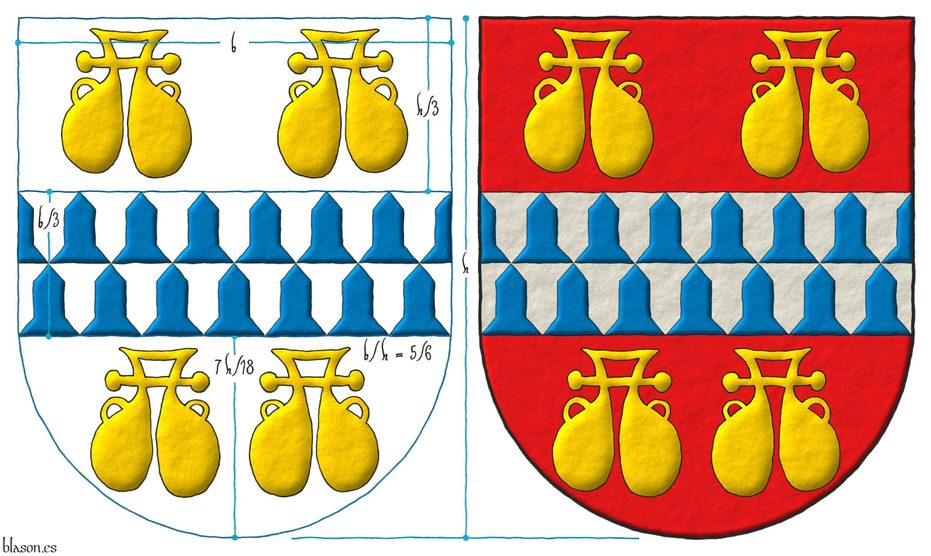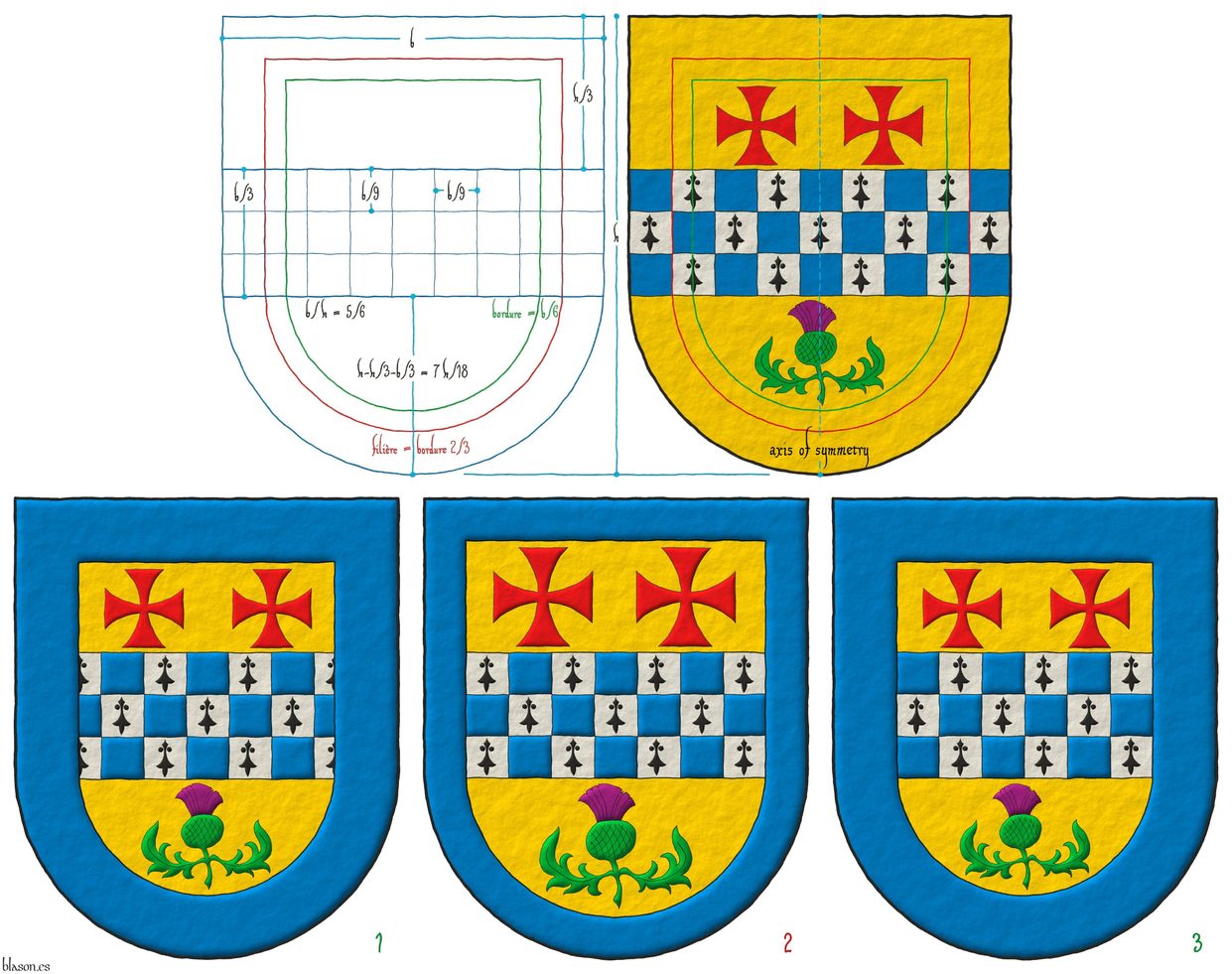
Design with a fess between 4 water-bougets
Design ideas
The heraldic art often involves resolving design challenges while maintaining both aesthetic balance and adherence to tradition. The coat of arms illustrated here draws inspiration from the Dethick-Dethicke family arms of Derbyshire, though it features distinct differences. This design explores the placement of water-bougets, a medieval water vessel, in a 2+2 arrangement, with a fess vair.
One key consideration when arranging charges in heraldry is proportionality. In this case, the fess occupies 1/3 of the coat of arms's width and is positioned 1/3 of the height from the chief, rather than at the exact center, allowing the charges to balance harmoniously. The shape of the shield itself also plays a role: rounded shields can accommodate a 2+2 arrangement more comfortably than shields with a pointed base, which are better suited to 2+1 arrangements, this is de case of Dethick's arms.
Another challenge in heraldic design is asymmetry. To address the natural curves of the shield, the water-bougets may vary slightly in size or placement. This intentional asymmetry can help create a visually appealing composition that respects both tradition and the unique constraints of each design, because, heraldry is not only about rules but also about creativity.
Gules, a fess vair between four water-bougets Or, two in chief and two in base.
Escudo de gules, una faja de veros acompañada de cuatro pares de odres de oro, dos en jefe y dos en punta.
Water-bouget
In German, they are called «Wasserschlauch» in English «water-bougets» or «oges», and in French «bouses» or «chantepleures».
There is no specific heraldic term for them in Castilian. Based on «chantepleures», one could use «cantimploras», which are metallic or at least rigid. On the other hand, «oges» could translate as «odres», as they are typically made of leather as in this case. Additionally, since «water-bouget» are designed as a pair to be carried by a donkey or other animal, I have decided to use «par de odres» to convey the idea of one on each side of the animal.
In English, when there is a single charge, that is, a pair of water vessels, it is written in singular as «water-bouget», as can be seen in [Fox-Davies, A. C.; 1909; figure 551]. [Friar, S.; 1987; page 68] defines «bouget» as «...a stylized representation of a yoke supporting two leather waterbags».
Blazon keywords: Gules, One, Fess, Vair, Between, Four, Water-bouget, Or, Two, In chief and In base.
Style keywords: Ratio, Outlined, Outlined in sable, Illuminated, Semi-circular and Freehand.
Classification: Interpreted, Schema and Coat of arms.


John Stuart, schema 2x3
Or, a fess chequey Argent, charged with an ermine spot, and Azure, between in chief two cross patty Gules, in base a thistle proper; a diminished bordure Azure.
The coat of arms of Reverend John Stuart, XVIII century, emblazoned by me in 3 approaches: 1) Classic bordure: Using a bordure with a width equal to 1/6 of the coat of arms' base. In the image, this is marked with texts and lines in Vert. Notice that the squares in columns 2 and 8 are split by the inner border of the bordure, which is unfortunate as it disrupts the design. 2) Diminished bordure: Using a narrower bordure with a width equal to 2/3 of the classic bordure, corresponding to 1 square of the fess chequey. In the image, this is marked with texts and lines in Gules. This approach avoids splitting any squares, allows for larger figures, and is my preferred solution. In England, diminished bordures, often simply blazoned as bordure, are more common than in Castile. 3) Without squares splitted: Retaining the classic bordure but shifting the fess chequey 1/2 square to either dexter or sinister to prevent splitting squares. However, this sacrifices the symmetry of the design. This last adjustment was used in the hatchment of Reverend John Stuart in St. George's Cathedral, Kingston, Ontario, 1785.
Blazon keywords: Or, Argent, Azure, One, Three, Nine, Two, Fess, Chequey, Charged, Ermine spot, Between, In chief, Cross, Patty, In base, Thistle, Proper and Diminished bordure.
Style keywords: Ratio, Outlined in sable, Illuminated, Semi-circular and Freehand.
Classification: Personal, Interpreted, Schema, Boa and Coat of arms.
Bearer: Stuart, John.


Stuart, John
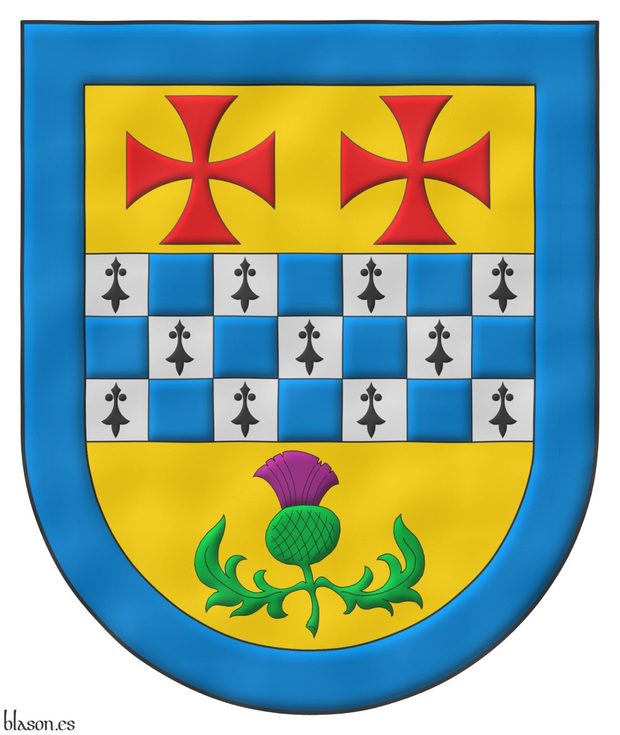
Or, a fess chequey Argent, charged with an ermine spot, and Azure, between in chief two cross patty Gules, in base a thistle proper; a diminished bordure Azure.
Escudo de oro, una faja ajedrezada de plata, cargada de una cola de armiño, y azur, acompañada en jefe de dos cruces patadas de gules, en base de un cardo al natural; una filiera de azur.
Coat of arms painted by me, highlighted with lights and shadows, outlined in Sable, with a semi-circular outer contour and with a watercolor finish.
Coat of arms of Reverend John Stuart, XVIII century, emblazoned by me.
Blazon keywords: Or, Argent, Azure, One, Three, Nine, Two, Fess, Chequey, Charged, Ermine spot, Between, In chief, Cross, Patty, In base, Thistle, Proper and Diminished bordure.
Style keywords: Outlined in sable, Illuminated, Semi-circular and Watercolor.
Classification: Personal, Interpreted, Boa and Coat of arms.
Bearer: Stuart, John.


Stewart of Scotland, lineage
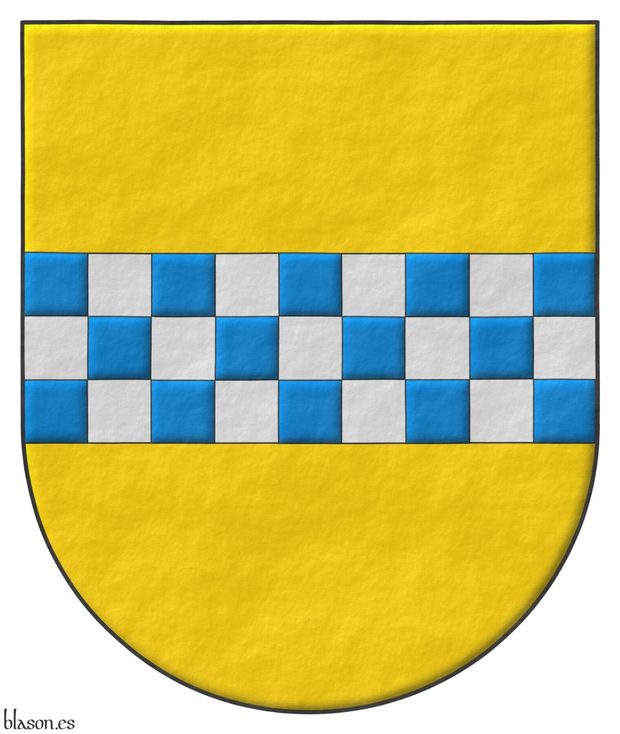
Or, a fess chequey Azure and Argent.
Escudo de oro, una faja ajedrezada de azur y plata.
Coat of arms emblazoned by me, illuminated with lights and shadows, outlined in Sable, with a semi-circular outer contour and with a rough finishing.
Coat of arms of the lineage Stewart of Scotland. I have emblazoned it with a fess chequy of 3 rows, symmetric and with 9 columns of squares, provided that its height is 1/3 of the width of the coat of arms.
Blazon keywords: Or, Azure, Argent, One, Three, Nine, Fess and Chequey.
Style keywords: Outlined in sable, Illuminated, Semi-circular and Rough.
Classification: Personal, Lineage, Interpreted, Boa and Coat of arms.
Bearer: Stewart of Scotland, lineage.


Boyd of Scotland, lineage
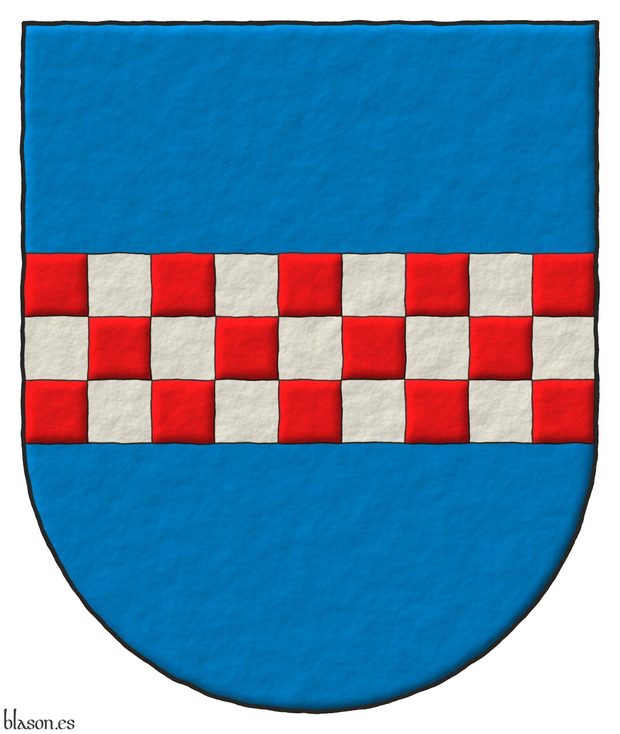
Azure, a fess chequey Gules and Argent.
Escudo de azur, una faja ajedrezada de gules y plata.
Coat of arms interpreted by me, highlighted with lights and shadows, contoured in Sable, with a semi-circular external shape and with a freehand finishing.
Coat of arms of the lineage Boyd of Scotland. I have emblazoned it with a fess chequy of 3 rows, symmetric and with 9 columns of squares, provided that its height is 1/3 of the width of the coat of arms.
Blazon keywords: Azure, Gules, Argent, One, Three, Nine, Fess and Chequey.
Style keywords: Outlined in sable, Illuminated, Semi-circular and Freehand.
Classification: Personal, Lineage, Interpreted, Boa and Coat of arms.
Bearer: Boyd of Scotland, lineage.


Janovsti of Janovic of Czechia, lineage
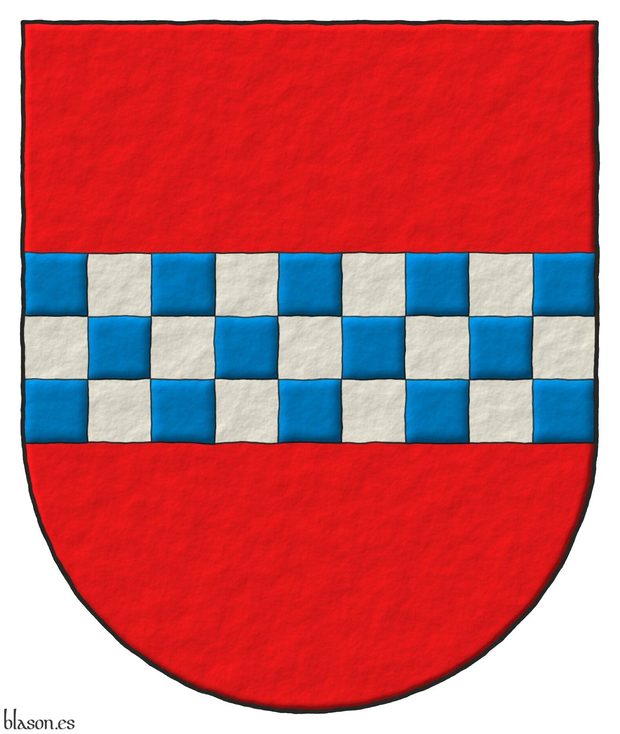
Gules, a fess chequey Azure and Argent.
Escudo de gules, una faja ajedrezada de azur y plata.
Arms emblazoned by me, highlighted with lights and shadows, contoured in Sable, with a semi-circular outer contour and with a freehand finish.
Coat of arms of the lineage Janovsti of Janovic of Czechia. It is also the coat of arms of the lineage Klenovsky of Klenove of Czech. I have emblazoned it with a fess chequy of 3 rows, symmetric and with 9 columns of squares, provided that its height is 1/3 of the width of the coat of arms.
Blazon keywords: Gules, Azure, Argent, One, Three, Nine, Fess and Chequey.
Style keywords: Outlined in sable, Illuminated, Semi-circular and Freehand.
Classification: Personal, Lineage, Interpreted, Boa and Coat of arms.
Bearer: Janovsti of Janovic of Czechia, lineage.
Blazon equivalent to: Lindsay of Scotland, lineage.


Lindsay of the Byres, lineage
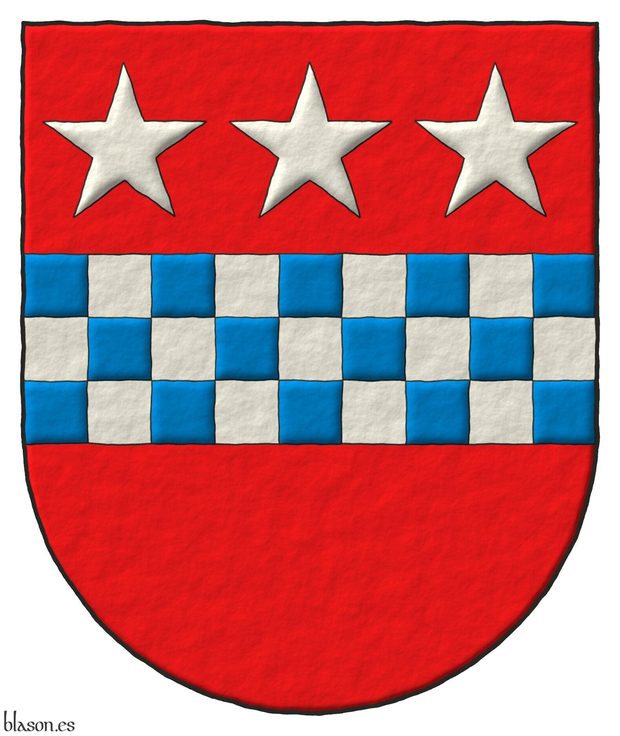
Gules, a fess chequey Azure and Argent, in chief three mullets of five points Argent.
Escudo de gules, una faja ajedrezada de azur y plata, en jefe tres estrellas de cinco puntas de plata.
Arms interpreted by me, highlighted with lights and shadows, outlined in Sable, with a semi-circular outer contour and with a freehand finish.
Coat of arms of the lineage Lindsay of the Byres. I have emblazoned it with a fess chequy of 3 rows, symmetric and with 9 columns of squares, provided that its height is 1/3 of the width of the coat of arms.
Blazon keywords: Gules, Azure, Argent, One, Three, Nine, Fess, Chequey, In chief and Mullet.
Style keywords: Outlined in sable, Illuminated, Semi-circular and Freehand.
Classification: Personal, Lineage, Interpreted, Boa and Coat of arms.
Bearer: Lindsay of the Byres, lineage.


Lindsay of Scotland, lineage
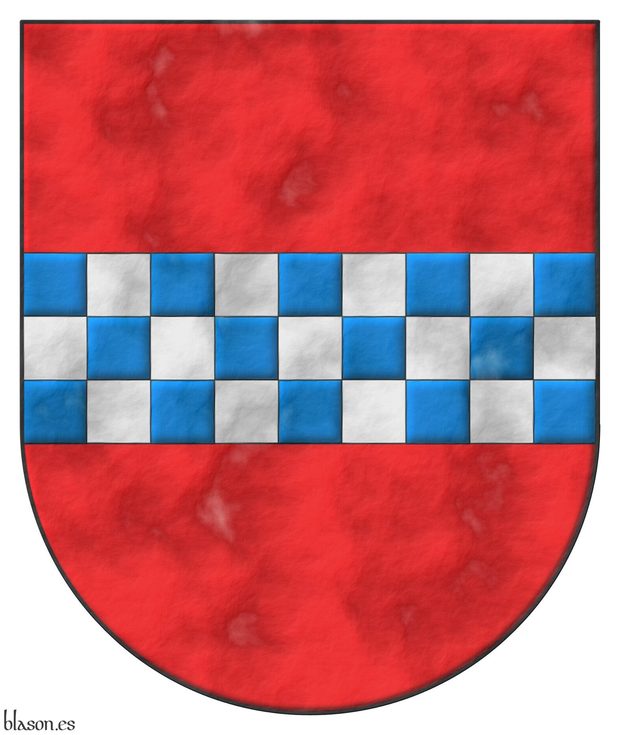
Gules, a fess chequey Azure and Argent.
Escudo de gules, una faja ajedrezada de azur y plata.
Arms depicted by me, highlighted with lights and shadows, outlined in Sable, with a semi-circular external shape and with a parchment finishing.
Coat of arms of the lineage Lindsay of Scotland. I have emblazoned it with a fess chequy of 3 rows, symmetric and with 9 columns of squares, provided that its height is 1/3 of the width of the coat of arms.
Blazon keywords: Gules, Azure, Argent, One, Three, Nine, Fess and Chequey.
Style keywords: Outlined in sable, Illuminated, Semi-circular and Parchment.
Classification: Personal, Lineage, Interpreted, Boa and Coat of arms.
Bearer: Lindsay of Scotland, lineage.
Blazon equivalent to: Janovsti of Janovic of Czechia, lineage.

Continue with: Mark, County of.
-
Language
-
Categories of heraldry
-
Divisions of the field
- Without divisions
- Party per pale
- Party per fess
- Party per bend
- Party per bend sinister
- Tierce
- Tierce sinister
- Tierced per pale
- Tierced per fess
- Tierced per bend
- Tierced pallwise inverted
- Quarterly
- Quarterly per saltire
- Gyronny
- Party per fess, the chief per pale
- Party per pale, the sinister per fess
- Party per fess, the base per pale
- Party per pale, the dexter per fess
- Chapé
- Chaussé
- Embrassé
- Contre-embrassé
- Party per chevron
- Enté
- Enté en point
- Flanched
-
Metals
-
Colours
-
Furs
-
Other tinctures
-
Ordinaries and sub-ordinaries
-
Diminutives of the ordinaries
-
Geometric charges
-
Composite ordinaries
-
Inanimate charges from Nature
Atom, Crescent, Diamond, Emerald, Estoile, Increscent, Lightning flash, Moon, Mount, Mullet, Mullet of four points, Orbital, Plough of Ursa Major, Rainbow, Ray of the sun, River, Sea, Snowflake, Sun, Sun in splendour, Sun of May, Trimount, Water and Wave.
-
Vegetal charges from Nature
Acorn, Apple, Apple tree, Ash, Bluebonnet, Camellia, Chrysanthemum, Cinquefoil, Cornflower, Dogwood flower, Double rose, Elm, Fleur de lis, Flower, Gourd, Holm oak, Hop cone, Kapok tree, Laurel, Lily, Linden, Lotus flower, Madonna lily, Mexican cedar tree, Oak, Olive tree, Palm tree, Plantain plant, Pomegranate, Poplar leaf, Rose, Shamrock, Sunflower, Thistle, Tree, Tulip, Vine and Wheat.
-
Animal charges from Nature
Badger, Bald eagle, Barbel, Barn owl, Bear, Beaver, Beetle, Bighorn sheep, Blackbird, Boar, Brach hound, Bull, Doe, Dog, Dolphin, Dove, Eagle, Elephant, Falcon, Female figure, Fish, Flame, Fly, Fox, Frog, Goat, Goldfinch, Goose, Heron, Horse, Hummingbird, Jaguar, Lark, Leopard, Lion, Lion passant, Lion rampant guardant, Lioness, Lynx, Male figure, Martlet, Merino ram, Owl, Panther, Parrot, Peacock, Pelican, Pelican in her piety, Puffin, Quetzal, Raven, Roe deer, Rooster, Savage, Seagull, Serpent, She-wolf, Stag, Starling, Talbot, Tyger, Vulture, Warren hound and Wolf.
-
Parts of natural charges
Arm, Beak, Branch, Caboshed, Chest, Claw, Covert, Dorsal fin, Eagle claw, Ermine spot, Escallop, Feather, Foot (palmiped), Foreleg, Forepaw, Hand, Head, Heart, Hoof, Leaf, Neck, Ostrich feather, Palm frond, Paw, Roe deers' attires, Shoulder, Sprig, Stags' attires, Stem, Swallow-tail, Tail, Tail addorsed, Tail fin, Talon, Tooth, Trunk, Trunk (elephant), Two hands clasped, Two wings in vol, Udder, Wheat spike, Wing and Wrist.
-
Artificial charges
Ace of spades, Anchor, Anvil, Arch, Arm vambraced, Armillary sphere, Arrow, Axe, Bell, Bell tower, Beret, Bonfire, Book, Bookmark, Bow, Branding iron, Bridge, Broken, Buckle, Cannon, Cannon dismounted, Cannon port, Canopy roof, Carbuncle, Castle, Celtic Trinity knot, Chain, Chess rooks, Church, Clarion, Clay pot, Closed book, Club, Column, Comb, Compass rose, Conductor's baton, Cord, Covered cup, Crozier, Crucible, Cuffed, Cup, Cyclamor, Dagger, Double vajra, Drum, Ecclesiastical cap, Fanon, Federschwert, Fleam, Four crescents joined millsailwise, Galician granary, Garb, Gauntlet, Geometric solid, Grenade, Halberd, Hammer, Harp, Host, Hourglass, Key, Key ward, Knight, Knot, Lantern, Letter, Line, Loincloth, Menorah, Millrind, Millstone, Millwheel, Monstrance, Mortar, Mullet of six points pierced, Nail, Non-classic artifact, Norman ship, Number, Oar, Oil lamp, Open book, Page, Pair of scales, Parchment, Pestle, Piano, Pilgrim's staff, Plough share, Polish winged hussar, Port, Portcullis, Potent, Quill, Ribbon, Rosette of acanthus leaves, Sabre, Sackbut, Sail, Scroll, Scythe, Sheaf of tobacco, Ship, Skirt, Spear, Spear's head, Stairway, Star of David, Step, Sword, Symbol, Tetrahedron, Torch, Tower, Trident, Trumpet, Turret, Two-handed sword, Wagon-wheel, Water-bouget, Wheel, Winnowing fan and With a turret.
-
Immaterial charges
Angel, Archangel, Basilisk, Dragon, Dragon's head, Garuda, Golden fleece, Griffin, Heart enflamed, Justice, Mermaid, Our Lady of Mercy, Ouroboros, Paschal lamb, Pegasus, Phoenix, Sacred Heart of Jesus, Saint George, Sea-griffin, Trinity, Triton, Unicorn, Winged hand and Wyvern.
-
External elements
-
Heraldic creations
-
References
-
Formats
-
Keywords on this page
Between, Watercolor, Chequey, Proper, Parchment, Azure, Boa, Boyd of Scotland, lineage, Thistle, Charged, Ermine spot, Cross, Four, Outlined, Outlined in sable, Two, In chief, In base, Coat of arms, Schema, Mullet, Fess, Diminished bordure, Personal, Gules, Illuminated, Interpreted, Janovsti of Janovic of Czechia, lineage, Lineage, Lindsay of Scotland, lineage, Lindsay of the Byres, lineage, Mark, County of, Semi-circular, Nine, Or, Water-bouget, Patty, Argent, Civic, Ratio, Rough, Stewart of Scotland, lineage, Stuart, John, Freehand, Three, One and Vair.

